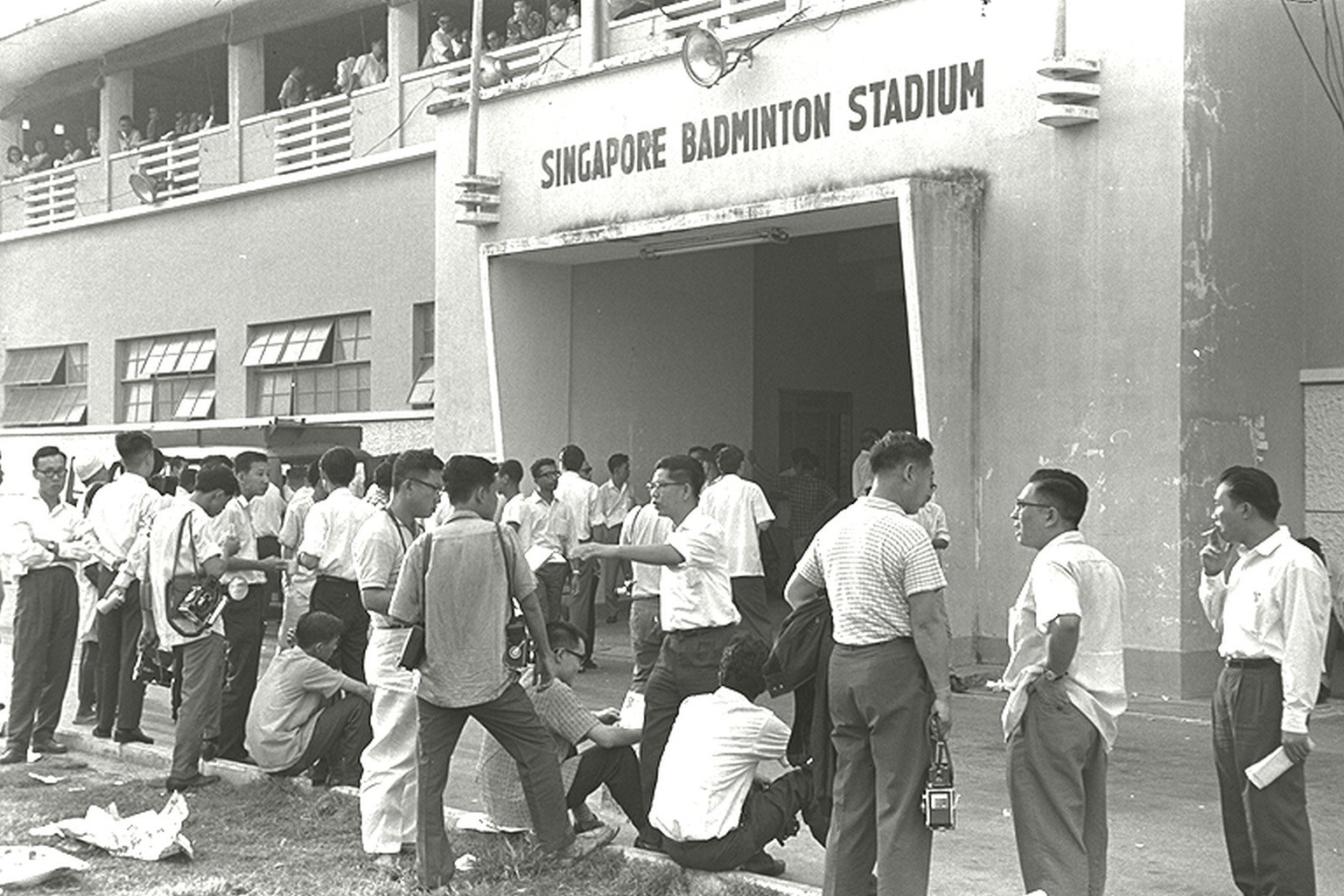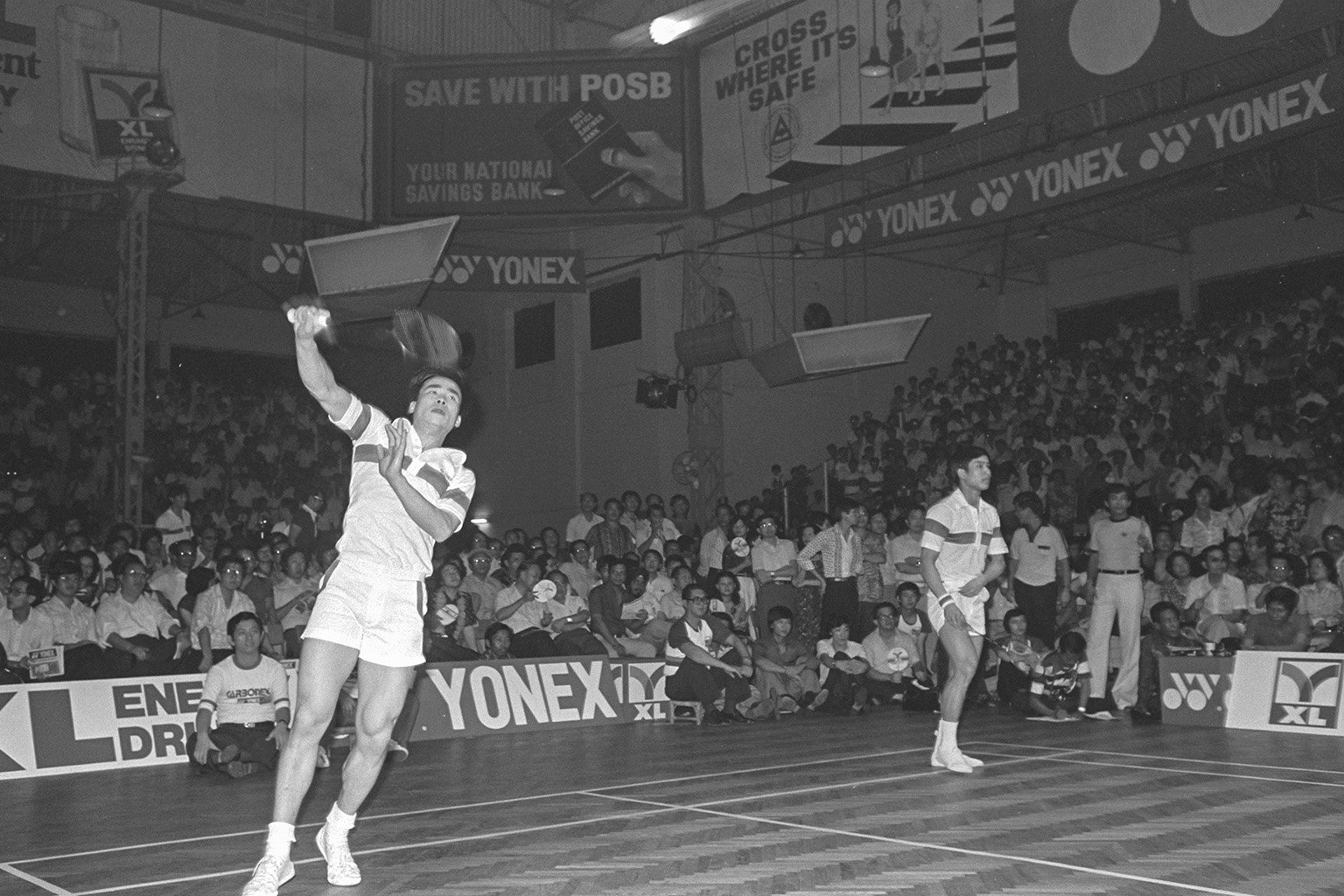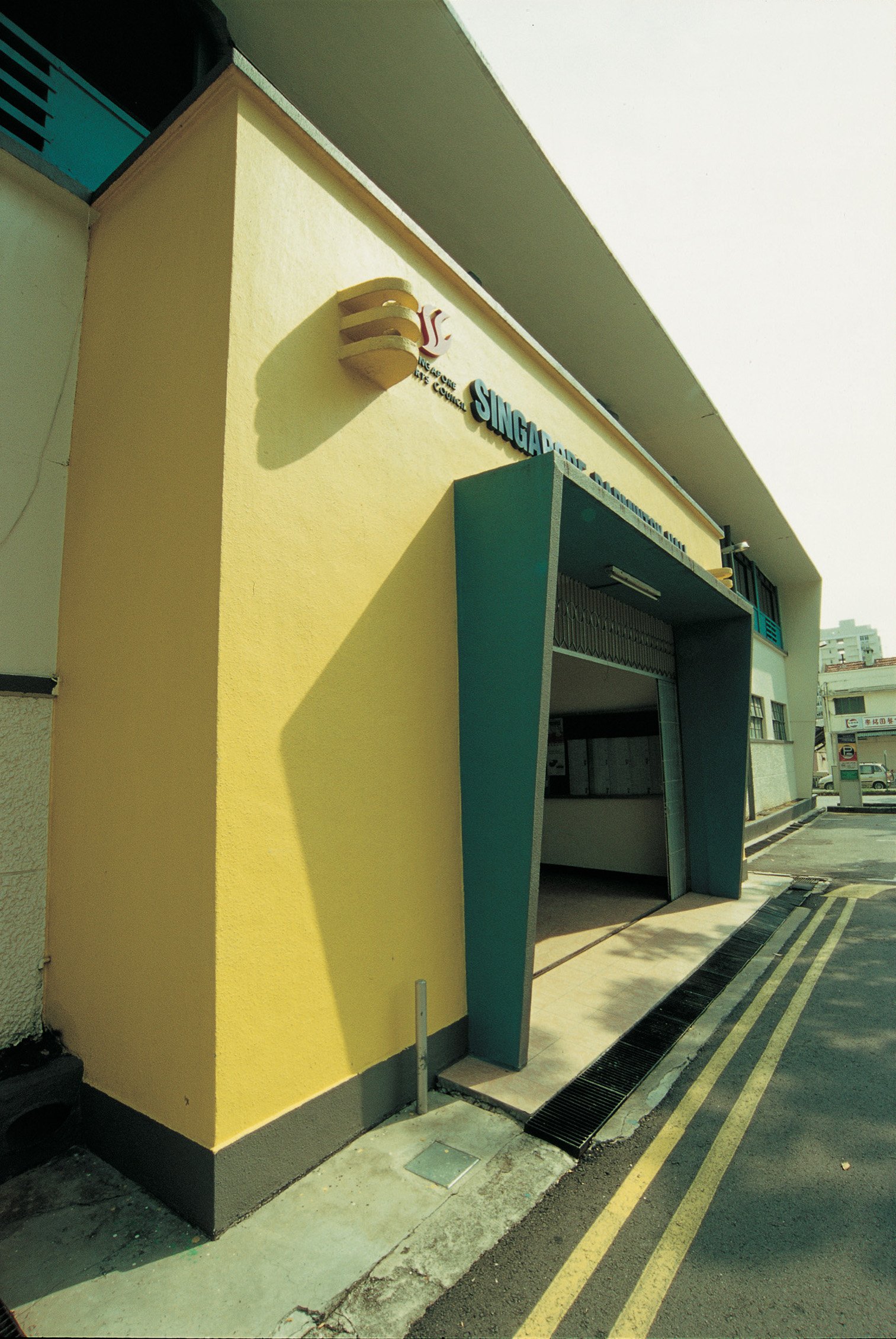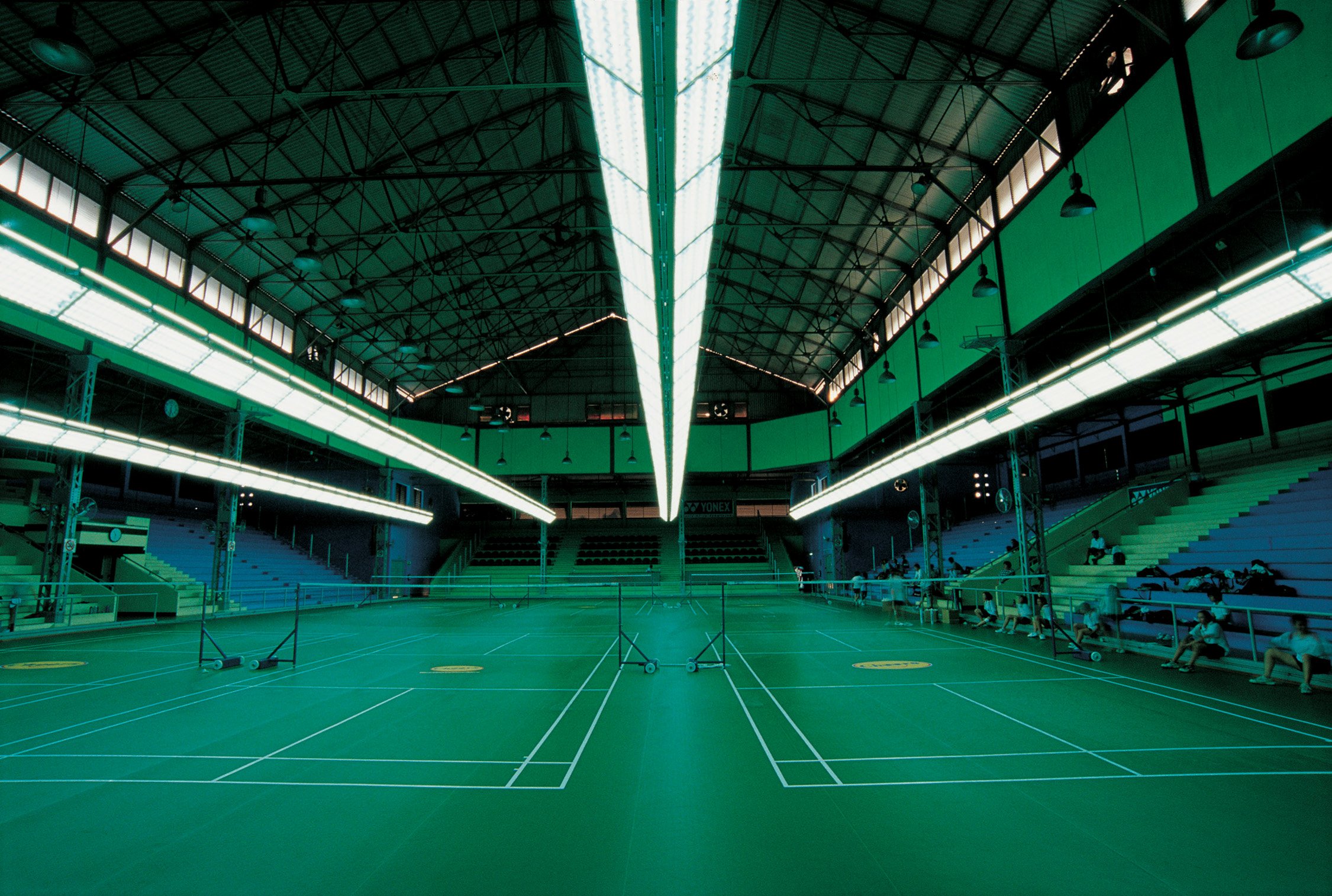Former Singapore Badminton Hall
The sports facility located on Guillemard Road was originally built to host the second Thomas Cup tournament in 1952. The Malayan team had won the right to host the international badminton tournament after winning the inaugural edition held in England in February 1949. The victory led to a need for a “modern, first-class” badminton hall, which the Malayan team manager-cum-captain Lim Chuan Geok had proposed at the start of the tournament to spur the growth of the sport.
Officially opened on 7 June 1952, the hall occupying an acre originally consisted of four parquet-floored courts with a capacity of 7,126. It also had two canteens, one on each side of its 45.7-metre-long building, and a reception room. The building was capped by an asbestos roof that was gently sloping and gave audiences a clear and unobstructed view from any part. It was cooled by 12 blowers, 8 exhaust fans to suck out the hot air and bracket fans attached to the 16 steel column.
Despite being completed in time for the Thomas Cup, the tournament was eventually held in the Happy World Stadium as the construction of the Singapore Badminton Hall was mired by controversy and questions throughout. In May 1949, the Singapore Badminton Association officially launched a fundraising drive for the estimated $300,000 required for a covered stadium that would house three badminton courts, seats for 5,000 to 7,000 spectators, changing rooms, showers and other facilities for badminton tournaments. However, public donations were not forthcoming. Even though only half the money required was raised in October 1951, Lim, who was also the association’s president, went ahead to construct the badminton hall as the Thomas Cup was only eight months away.
The controversial decision led to the high-profile resignation of the hall’s fundraising committee president, John Laycock. Besides questioning if it was wise to proceed without enough funds and if the building costs were underestimated, Laycock wondered why a badminton hall should have two canteens and a banquet hall. In response, Lim explained that the additional facilities were a means for raising revenue and that the hall was a “paying proposition” as he had obtained permission to use the hall for both sporting and social events with the exception of professional boxing and wrestling.
The construction costs of the hall eventually almost tripled to the final sum of $800,000. During construction, the SBA tried seeking a government loan, but the legislative council declined because it had already agreed to rent out the three-acre site for the hall at just a dollar annually for the first five years. The hall was eventually completed with a loan from SBA patron, Aw Boon Haw, and because the contractor C.H. Tong’s Union Construction Company agreed to collect his payment via the proceeds from events instead.
The hall finally held the 1955 edition of the Thomas Cup (which Malaya won for the third time in a row) as well as in 1958—but the latter only after the government stepped in to be caretaker of the facility as it was plagued by financial woes. Besides badminton, the hall was a venue for other sporting events such as table tennis, sepak takraw and taekwan-do too. Over the decades, has also hosted many entertainment events, including performances by international pop stars such as Cliff Richard and the Shadows (1961) as well as the Rolling Stones (1965) and local stars including the “Queen of Striptease” Rose Chan (1956 and 1957) and The Quests (1965). The hall was the venue of choice for trade fairs, corporate dinners and political events too—including as the vote counting station for the 1962 referendum on the merger of Singapore and Malaya. Such an illustrious history led to it being the first sports facility in Singapore to be designated a historic site by the National Heritage Board in 1999.
In 1978, the government’s Singapore Sports Council officially took over the venue after two decades of leasing the hall for various events to help the SBA clear its debts. The SBA continued operating in the hall and even opened an adjacent three-level clubhouse with more badminton courts and offices in May 1986. When SBA’s 30-year lease with the government expired in 2008, the association finally vacated the hall and clubhouse it built as the government raised the annual lease from under S$100,000 to S$1.164 million. Both buildings have since been leased out to private developers that have adapted it as leisure and entertainment facilities.
Locations: 100 Guillemard Rd, Singapore 399718
Architects: Ng Keng Siang
Year: 1952
Status: Not conserved





Sources:
The Straits Times. ‘$300,000 Hall Is Singapore’s Aim’. 31 May 1949.
The Straits Times. ‘Badminton Hall “Hero” Is Contractor’. 11 May 1952.
Diemer, Christine. ‘World’s Best Shuttle Stadium Opens Today’. Singapore Standard. 7 June 1952.
The Straits Times. ‘Don’t Be Alarmed over Hall, Says Lim’. 18 September 1951.
The Straits Times. ‘Happy World Will Be Thomas Cup Venue’. 10 March 1952.
The Singapore Free Press. ‘Laycock Resigns’. 6 September 1951.
The Singapore Free Press. ‘Lim Chuan Geok’s Plan for Halls’. 29 January 1949.
Lim, Kee Chan. ‘Hall Is “transferred” without Any Fuss’. The Straits Times. 11 February 1958.
The Straits Times. ‘Save the Hall Appeal’. 11 March 1954.
The Straits Times. ‘Singapore Refuses Badminton Hall Loan by 18 Votes to Three’. 21 February 1952.
Teo, Anna. ‘A Lift for Shuttlers’. Business Times. 1 August 1985.
Malaya Tribune. ‘Victory with Honour’. 28 February 1949.
Wang, Jeanette. ‘Singapore Badminton Hall Likely to Close in Jan’. The Straits Times. 28 July 2007.
The Straits Times. ‘Work Starts on Thomas Cup Hall’. 2 October 1951.
Last modified on 15 December 2022. Written by Justin Zhuang. Adapted from Jiat-Hwee Chang, Justin Zhuang and Darren Soh, Everyday Modernism: Architecture and Society in Singapore (Singapore: Ridge Books, 2022).

